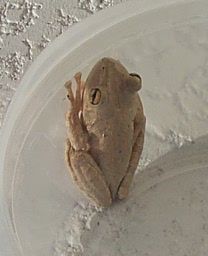| New Photos | Animal News | Animal Sounds | Animal Movies | Upload Photo | Copyright | Korean |
|---|
| Funny Animal Photos | Monsters in Animalia | Wiki Articles Fun Facts about Animals | Links | Home | Mobile A.P.A. |
|---|
| Image Info | Original File Name: Cuban-treefrog-Cuban Tree Frog (Osteopilus septentrionalis).jpg Resolution: 208x256 File Size: 14546 Bytes Upload Time: 2007:10:08 17:27:30 | |
| Author | Name (E-mail): Unknown | |
| Subject | Cuban Tree Frog (Osteopilus septentrionalis) - Wiki | |
 |
| Email : E-Card | Poster | Web Master Delete Edit Info Admin |
| Description | Cuban Tree Frog (Osteopilus septentrionalis) - Wiki
Cuban tree frog
The Cuban Tree Frog (Osteopilus septentrionalis) is the largest species of tree frog in North America, native to Cuba and neighboring Caribbean islands. It has become increasingly numerous in central to southern Florida, where it was accidentally introduced and is considered an invasive species. Description The Cuban tree frog ranges in 1.5 to 5.5 inches in length and is anywhere from a gray, light brown, to pale green in color. They also have the ability to switch between these color variations depending on their environment but they usually retain a mottled pattern (slightly spotted) with some banding on their legs. Some also have yellow coloring tucked around their leg areas. Males are smaller than females, and have darker throats and nuptial pads in the breeding seasons. Diet The Cuban tree frog is infamous for its huge appetite. Their diet includes almost anything they can overpower, which fits into their mouth, including: insects, other frogs (even frogs of their own species), snakes, lizards, and young birds. Conservation concerns The Cuban tree frog is considered to be an invasive species in the continental United States, consuming native frogs and lizards and posing a threat to the biodiversity of the areas into which it spreads. It has spread as far as southern Georgia as of 2004. It hitchhikes on vehicles or relocated soil and plants. The native green and squirrel tree frogs are rapidly disappearing due to its presence. They are also believed to cause power outages by sitting on transformers on electrical poles. In captivity Cuban tree frogs are commonly available in the pet trade. They are inexpensive, and when cared for properly tend to live 5-10 years. They feed readily on commercially available crickets. http://en.wikipedia.org/wiki/Cuban_tree_frog
| |||
| Copyright Info | AnimmalPicturesArchive.com does not have the copyright for this image. This photograph or artwork is copyright by the photographer or the original artist. If you are to use this photograph, please contact the copyright owner or the poster. |
|
|
|
| |||||||
| CopyLeft © since 1995, Animal Pictures Archive. All rights may be reserved. | ||||||||
Stats